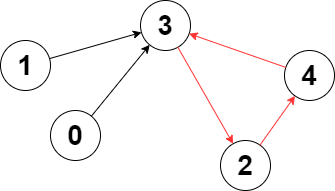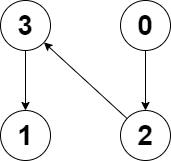2360. Longest Cycle in a Graph
2360. Longest Cycle in a Graph
1 | You are given a directed graph of n nodes numbered from 0 to n - 1, where each node has at most one outgoing edge. |
Example 1:

1
2
3
4Input: edges = [3,3,4,2,3]
Output: 3
Explanation: The longest cycle in the graph is the cycle: 2 -> 4 -> 3 -> 2.
The length of this cycle is 3, so 3 is returned.
Example 2:

1
2
3Input: edges = [2,-1,3,1]
Output: -1
Explanation: There are no cycles in this graph.
Constraints:
1 | - n == edges.length |
Difficulty : Hard
Solution
int[] timeVisited = new int[n] : Create an array timeVisited of size n to store the visit sequence for each node.
int time = 1: Initialize a variable time to store the current visit sequence, starting from 1.
int ans = -1: Initialize the answer variable as -1. It will store the length of the longest cycle found.
Iterate through all nodes in the graph with the loop for (int i = 0; i < n; i++).
Check if the current node i is visited. If yes, skip the current iteration: if (timeVisited[i] > 0) continue;.
Initialize a variable startTime equal to the current time. This variable will store the visit sequence value when the traversal started for node i.
Create a loop using int j = i; and while (j != -1 && timeVisited[j] == 0) to traverse the graph along the directed edges starting from the current node i. The loop stops when it reaches a node with no outgoing edges (edges[j] == -1) or when it encounters a previously visited node (timeVisited[j] != 0).
Inside the loop, update the timeVisited array for the current node j with the current time value and increment time by 1: timeVisited[j] = time++;.
Move to the next node in the graph: j = edges[j];.
After the loop, check if the traversal ended on a previously visited node that was visited after the startTime. If yes, calculate the length of the cycle as time - timeVisited[j] and update the ans variable with the maximum value between the previously stored answer and the newly calculated cycle length: if (j != -1 && timeVisited[j] >= startTime) { ans = Math.max(ans, time - timeVisited[j]); }.
After completing the outer loop, return the answer variable ans, which stores the length of the longest cycle in the graph. If no cycles are found, it will return -1 as initialized.
1 | class Solution { |